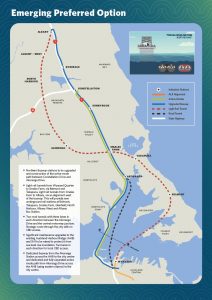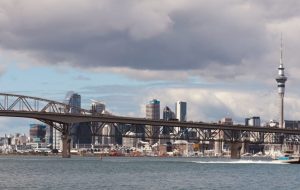
Mixed reaction to government’s multi-billion Auckland harbour tunnels plan
Last Sunday, the Labour government revealed plans to construct three new tunnels as part of their election promise, forming a new harbor bridge spanning the Waitematā Harbour in Auckland. Of these, two will be dedicated underwater tunnels for automobiles, and one will be a light rail tunnel, with an estimated total cost of up to $45 billion (NZD).
The two automobile-exclusive underwater tunnels will each consist of three lanes and connect Auckland’s CBD to the North Shore’s Akoranga, covering a length of approximately 5-6 kilometers.
The light rail tunnel, spanning 21 kilometers, will begin at Wynyard Quarter and link to Albany on the North Shore. It will include stops at six locations, including Takapuna and Belmont.
Prime Minister Chris Hipkins emphasized, “To alleviate congestion, we need to improve both roads and public transportation, offering citizens a choice. By complementing the existing harbor bridge with these new tunnels, Aucklanders can travel north, south, east, and west using public transport. The existing bridge’s vulnerability has been highlighted due to recent strong winds and weather events, making it essential to reduce dependence and secure the future of Auckland’s transport network.”
With part of the existing bridge’s lanes dedicated to buses, bicycles, and pedestrians, four lanes will continue to serve as car lanes. Upgrades to pedestrian pathways and bicycle lanes are under consideration to facilitate walking and cycling across the harbor.
Construction is expected to commence with the automobile-exclusive underwater tunnel by 2029, while the remainder will be executed in stages, likely taking a total of 10 years. Various funding methods, including tax collection, are being considered to cover the substantial construction costs.
Upon the completion of the tunnels, Waka Kotahi (New Zealand Transport Agency) anticipates a 20% reduction in travel time for public transport from Takapuna to the city center and a 21% reduction from Albany to the CBD. The government aims to increase harbor bridge commuting using public transport up to 275% by 2051.
Beyond the tunnels, plans to mitigate flood risks include the expansion of the North Shore’s State Highway 1.
Divergent Reactions
A North Shore representative questioned how the Labour Party plans to fund the staggering $45 billion construction cost, raising doubts about the feasibility of proceeding with the construction of three tunnels.
Simon Bridges, the representative of the Auckland Business Chamber, also expressed skepticism, suggesting that such substantial expenditures should be justified by equivalent benefits.
While a North Shore resident welcomed the notion of an alternative to the harbor bridge, they opposed the construction plan, noting that if construction begins in 2029 and takes 10 years, “It’s a great idea, but unfortunately, it will take too long to complete in my lifetime.”
Simeon Brown, an MP from the National Party, deemed Labour’s move a “politically driven strategy in a desperate situation” and criticized the feasibility of the light rail tunnel.
Meanwhile, the opposition National Party also unveiled their transportation plans as an electoral promise, encompassing the North West Expressway, public transport expansion (29 billion NZD, 4-10 years), connecting the airport to Botany (21 billion NZD, 4-10 years), and completing the Eastern Busway bus route in the eastern region (7 billion NZD, 1-3 years).

▲ Tunnel construction plan, red light rail tunnel / 터널 건설안, 빨간색이 경전철 터널
정부 ‘오클랜드 하버 3개 터널’ 계획 발표, 엇갈린 반응
지난 일요일 노동당(Labour) 정부는 오클랜드 하버(Waitematā)를 건너는 새로운 하버브리지로 3개의 터널 건설 계획을 총선 공약으로 발표했다. 2개는 자동차 전용 해저 터널이고 1개는 경전철(light rail) 터널로 최대 450억 달러가 소요될 것으로 예상된다.
자동차 전용 해저 터널은 3차선 터널을 양 방향으로 2개 건설하여, 오클랜드 시내 CBD에서 노스쇼어 Akoranga까지 연결된다. 약 5~6km 길이다.
경전철 터널은 윈야드 쿼터(Wynyard Quarter)에서 출발, 노스쇼어 알바니(Albany)까지 연결되는 21km 길이다. 중간에 타카푸나(Takapuna)와 벨몬트(Belmont) 등 총 6곳에 정차한다.
크리스 힙킨스(Chris Hipkins) 총리는 “혼잡을 줄이려면 도로와 대중 교통 모두를 개선하여 시민들에게 선택권을 주어야 한다. 기존 하버브리지와 새로운 터널 건설로 오클랜드 시민들이 대중 교통을 이용해 북쪽에서 남쪽, 동쪽 및 서쪽으로 이동할 수 있다. 기존 하버브리지는 최근 강풍, 기상 현상에 따라 안전을 위해 폐쇄되는 등 취약성이 드러났는데, 새로운 터널은 하버브리지에 대한 의존도를 줄이는 동시에 도시를 이동할 수 있는 새롭고 빠른 옵션을 만들어 오클랜드 교통 네트워크의 미래를 보장한다”고 설명했다.
기존 하버브리지에서 일부 차선은 버스/자전거/도보 전용 도로로 바뀐다. 4개의 차선은 계속해서 자동차 도로로 유지된다. 걸어서 또는 자전거로 하버를 건널 수 있게 보행로 업그레이드가 고려되고 있다.
건설은 자동차 전용 해저 터널부터 2029년에 시작될 것으로 예상되며, 나머지는 단계적으로 시행되어 총 10년이 걸릴 것으로 보인다.
거액의 건설 비용은 세금을 걷어 조달하는 등 다양한 방법이 고려되고 있다.
교통국(Waka Kotahi)은 터널이 건설되면 대중교통으로 타카푸나(Takapuna)에서 시내까지 이동 시간이 20% 단축, 알바니(Albany)에서 시내 CBD까지는 21% 단축될 것으로 예상했다. 2051년까지 대중 교통을 이용한 하버브리지 이동을 275%까지 늘릴 방침이다.
터널 외에 홍수 위험을 줄이기 위해 노스쇼어의 1번 고속도로 확충 건설도 계획되었다.
“엇갈린 반응”
노스쇼어 지역의 한 구의원은 노동당이 450억 달러라는 막대한 건설 비용을 어떻게 조달하여 3개의 터널 건설을 진행할 것인지 의문을 제기했다.
또한, 오클랜드 상공회의소(Auckland Business Chamber)의 사이먼 브리지스(Simon Bridge) 대표 역시 의문을 제기하면서 거액의 지출이 정당화되려면 그만한 이점이 있어야 한다고 지적했다.
노스쇼어의 한 주민은 제2의 하버브리지 대안은 환영하지만 공사가 2029년에 시작해 10년이 걸린다면 “훌륭한 생각이지만 불행하게도 내가 살아있는 동안에는 완공되지 않을 만큼 너무 오래 걸린다”며 건설안에 반대했다.
국민당(National)의 시미언 브라운(Simeon Brown) 의원은 노동당이 “절박한 상황에서 내놓은 정치적 전략”이라고 불렀고 경전철 터널은 타당하지 않다고 말했다.
한편, 야당인 국민당도 교통 계획을 선거 공약으로 발표했다: 그중에는 오클랜드의 North West 고속도로, 대중교통 확충(29억 달러, 4-10년), 공항에서 보타니(Botany)까지 연결(21억 달러, 4-10년), 동부지역 Eastern Busway 버스 도로 완공(7억 달러. 1-3년) 등이 포함되었다.

